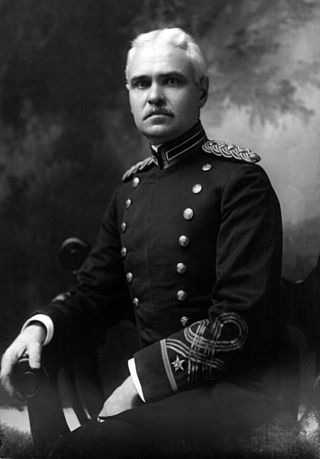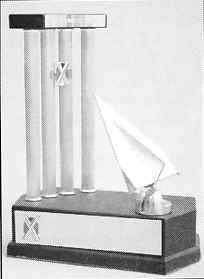
George Washington Goethals was a United States Army general and civil engineer, best known for his administration and supervision of the construction and the opening of the Panama Canal. He was the State Engineer of New Jersey and the Acting Quartermaster General of the United States Army.

Operation HIGHJUMP, officially titled The United States Navy Antarctic Developments Program, 1946–1947,, was a United States Navy (USN) operation to establish the Antarctic research base Little America IV. The operation was organized by Rear Admiral Richard E. Byrd, Jr., USN, Officer in Charge, Task Force 68, and led by Rear Admiral Ethan Erik Larson, USN, Commanding Officer, Task Force 68. Operation HIGHJUMP commenced 26 August 1946 and ended in late February 1947. Task Force 68 included 4,700 men, 70 ships, and 33 aircraft.

The Iven C. Kincheloe Award recognizes outstanding professional accomplishment in the conduct of flight testing. It was established in 1958 by the Society of Experimental Test Pilots in memory of test pilot and Korean War ace Iven C. Kincheloe, United States Air Force, who died during flight testing.

The Air Force Institute of Technology (AFIT) is a postgraduate institution and provider of professional and continuing education for the United States Armed Forces and is part of the United States Air Force. It is in Ohio at Wright-Patterson Air Force Base, near Dayton. AFIT is a component of the Air University and Air Education and Training Command.
The Ronne Antarctic Research Expedition (RARE) was an expedition from 1947–1948 which researched the area surrounding the head of the Weddell Sea in Antarctica.

The James H. Doolittle Award is an honor presented annually by the Society of Experimental Test Pilots. It is an award for "outstanding accomplishment in technical management or engineering achievement in aerospace technology". The award consists of a perpetual trophy on permanent display at SETP headquarters, and a smaller replica presented to the recipient. It is named after General James Doolittle, famous for the Doolittle Raid on Tokyo during World War II.

The Civil Engineer Corps (CEC) is a staff corps of the United States Navy. CEC officers are professional engineers and architects, acquisitions specialists, and Seabee Combat Warfare Officers who qualify within Seabee units. They are responsible for executing and managing the planning, design, acquisition, construction, operation, and maintenance of the Navy's shore facilities. The Civil Engineer Corps is under the command of the Chief of Civil Engineers and Commander, Naval Facilities Engineering Systems Command. On 12 August 2022, RADM Dean VanderLey relieved RADM John W. Korka, becoming the 46th commander of NAVFAC and Chief of Civil Engineers.
The Order of battle for the American airborne landings in Normandy is a list of the units immediately available for combat on the Cotentin Peninsula between June 6, 1944, and June 15, 1944, during the American airborne landings in Normandy during World War II.
The Secretary of the Navy's Advisory Subcommittee on Naval History was formally established in 1956 and is the second oldest of the historical advisory committee's within the United States Department of Defense.
Battle of Chosin Reservoir order of battle is a list of the significant units that fought in the Battle of Chosin Reservoir between November 27, 1950 and December 13, 1950.
The Herman R. Salmon Technical Publications Award recognizes the most outstanding technical paper published in Cockpit magazine, a quarterly journal of the Society of Experimental Test Pilots. The award was established in 1971 and renamed in 1981 to honor the memory of test pilot Herman R. "Fish" Salmon who was killed in an aircraft accident.
The Ray E. Tenhoff Award recognizes the most outstanding technical paper presented at the annual Society of Experimental Test Pilots (SETP) Symposium in Los Angeles, California. The award was established in 1962 and is given in memory of Convair test pilot, Ray E. Tenhoff, founder and first president of SETP. Tenhoff was killed in B-58 Hustler accident on April 22, 1960.

The Association of Naval Services Officers (ANSO) is an organization dedicated to expanding the presence of Hispanic and Latino Americans in the Sea Services of the United States Navy, the United States Marine Corps, the United States Coast Guard, and the United States Merchant Marine. The organization was established in 1981. ANSO connects and networks Hispanics in the Coast Guard, Marine Corps, and Navy together and supports recruitment and retention of officers in the Sea Services. Programs include mentoring, training, and education.
Space Pioneer Awards or NSS Space Pioneer Awards are the annual awards given by National Space Society, an independent non-profit educational membership organisation, to individuals and teams who have opened the space frontier.
The 1891 Birthday Honours were appointments by Queen Victoria to various orders and honours to reward and highlight good works by citizens of the British Empire. The appointments were made to celebrate the official birthday of The Queen, and were published in the London Gazette on 29 May 1891 and in The Times on 30 May 1891.
The 1919 Birthday Honours were appointments by King George V to various orders and honours to reward and highlight good works by citizens of the British Empire. The appointments were made to celebrate the official birthday of The King, and were published in The London Gazette from 3 June to 12 August. The vast majority of the awards were related to the recently ended War, and were divided by military campaigns. A supplementary list of honours, retroactive to the King's birthday, was released in December 1919.

On 21 July 1944, United States Marine and Army forces invaded the island of Guam, the southernmost of the Mariana Islands chain in the Central Pacific, with the intent to take control of the island from the Imperial Japanese Army. Operation Forager II, as it was called by American planners, was a phase of the Pacific Theatre of World War II.
The Battle of Hong Kong was one of the first battles of the Pacific War in World War II.

On February 19, 1945, men of the United States Marine Corps invaded the island of Iwo Jima, part of the Volcano Islands chain, in the North Pacific. This invasion, known as Operation Detachment, was a phase of the Pacific Theatre of World War II. The American goal was to establish multiple airfields that would allow escort fighters to accompany long-range bombers in their attacks on the Japanese home islands, as well as providing a place for damaged bombers to land on the return flight.









